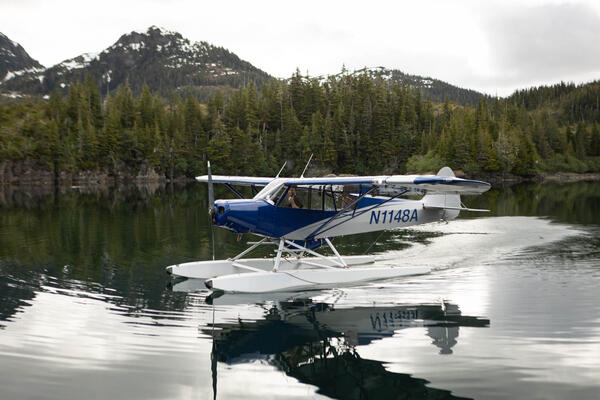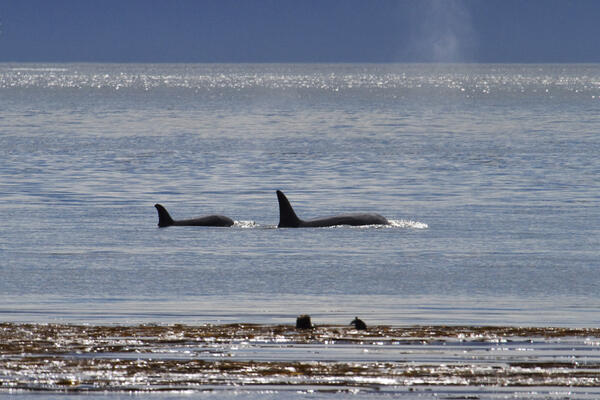Float plane taking off in Prince William Sound for sea otter aerial survey
Float plane taking off in Prince William Sound for sea otter aerial surveyNorth River Air pilot Taj Shoemaker getting ready for takeoff in Prince William Sound.

An official website of the United States government
Here's how you know
Official websites use .gov
A .gov website belongs to an official government organization in the United States.
Secure .gov websites use HTTPS
A lock () or https:// means you’ve safely connected to the .gov website. Share sensitive information only on official, secure websites.
Kimberly Kloecker is a marine biologist at the Alaska Science Center and is part of the Nearshore Marine Ecosystem Research Program. Her work centers on sea otter behavior, ecology, and health.
1998 - Present Ecologist, USGS, Alaska Science Center, Anchorage, Alaska
1996 - 1998 Statistical Assistant, USGS, Alaska Biological Science Center, Anchorage, Alaska
1993 - 1995 Peace Corps Volunteer, U.S. Peace Corps, Fiji
1992 - 1992 Specialist, R/V Nathaniel B. Palmer Weddell Sea, Antarctica
M.S. 1993 University of California Santa Cruz, Santa Cruz, CA Marine Science
B.S. 1989 Michigan State University, East Lansing, MI Biology

North River Air pilot Taj Shoemaker getting ready for takeoff in Prince William Sound.
North River Air pilot Taj Shoemaker getting ready for takeoff in Prince William Sound.
A resting sea otter in the Homer harbor, Alaska. Photo was taken in 2011. Sea otters provide one of the best documented examples of top-down forcing effects on the structure and function of nearshore marine ecosystems in the North Pacific Ocean.
A resting sea otter in the Homer harbor, Alaska. Photo was taken in 2011. Sea otters provide one of the best documented examples of top-down forcing effects on the structure and function of nearshore marine ecosystems in the North Pacific Ocean.
A resting sea otter with eyes closed. Photo taken in the Homer harbor in Alaska. Sea otters provide one of the best documented examples of top-down forcing effects on the structure and function of nearshore marine ecosystems in the North Pacific Ocean
A resting sea otter with eyes closed. Photo taken in the Homer harbor in Alaska. Sea otters provide one of the best documented examples of top-down forcing effects on the structure and function of nearshore marine ecosystems in the North Pacific Ocean

A sea otter resting in kelp as two orcas swim past. Photo taken in Glacier Bay at Point Carolus, Alaska
A sea otter resting in kelp as two orcas swim past. Photo taken in Glacier Bay at Point Carolus, Alaska
A female sea otter resting in the morning light in Cook Inlet Alaska.
A female sea otter resting in the morning light in Cook Inlet Alaska.

Brian Robinson (USGS) and Ben Weitzman (NOAA) record observations along nearshore transects in Kachemak Bay, Alaska. USGS is studying the migration strategies and movement ecology of Black Oystercatchers as part of the new tracking study.
Brian Robinson (USGS) and Ben Weitzman (NOAA) record observations along nearshore transects in Kachemak Bay, Alaska. USGS is studying the migration strategies and movement ecology of Black Oystercatchers as part of the new tracking study.

USGS Biologist Caitlin Marsteller prepares to release a Black Oystercatcher after assisting with the collection of morphometric data and tagging. Data were collected from Black Oystercatchers as part of a new study to better understand migration strategies and movement ecology of the species.
USGS Biologist Caitlin Marsteller prepares to release a Black Oystercatcher after assisting with the collection of morphometric data and tagging. Data were collected from Black Oystercatchers as part of a new study to better understand migration strategies and movement ecology of the species.

USGS Biologist Caitlin Marsteller releases a Black Oystercatcher after assisting with the collection of morphometric data and tagging. Data were collected from Black Oystercatchers as part of a new study to better understand migration strategies and movement ecology of the species.
USGS Biologist Caitlin Marsteller releases a Black Oystercatcher after assisting with the collection of morphometric data and tagging. Data were collected from Black Oystercatchers as part of a new study to better understand migration strategies and movement ecology of the species.
A young sea otter foraging for small invertebrates off an emergent rock covered with seaweed, snails, and barnacles. Photo taken in Prince William Sound, Alaska.
A young sea otter foraging for small invertebrates off an emergent rock covered with seaweed, snails, and barnacles. Photo taken in Prince William Sound, Alaska.
A juvenile female sea otter eating small green urchins in the intertidal. Photo taken in Glacier Bay near Geikie Inlet, Alaska.
A juvenile female sea otter eating small green urchins in the intertidal. Photo taken in Glacier Bay near Geikie Inlet, Alaska.
A sea otter at sunset eating a basket star in Glacier Bay near Bartlett Cove, Alaska
A sea otter at sunset eating a basket star in Glacier Bay near Bartlett Cove, Alaska

North River Air pilot Taj Shoemaker getting ready for takeoff in Prince William Sound.
North River Air pilot Taj Shoemaker getting ready for takeoff in Prince William Sound.
A resting sea otter in the Homer harbor, Alaska. Photo was taken in 2011. Sea otters provide one of the best documented examples of top-down forcing effects on the structure and function of nearshore marine ecosystems in the North Pacific Ocean.
A resting sea otter in the Homer harbor, Alaska. Photo was taken in 2011. Sea otters provide one of the best documented examples of top-down forcing effects on the structure and function of nearshore marine ecosystems in the North Pacific Ocean.
A resting sea otter with eyes closed. Photo taken in the Homer harbor in Alaska. Sea otters provide one of the best documented examples of top-down forcing effects on the structure and function of nearshore marine ecosystems in the North Pacific Ocean
A resting sea otter with eyes closed. Photo taken in the Homer harbor in Alaska. Sea otters provide one of the best documented examples of top-down forcing effects on the structure and function of nearshore marine ecosystems in the North Pacific Ocean

A sea otter resting in kelp as two orcas swim past. Photo taken in Glacier Bay at Point Carolus, Alaska
A sea otter resting in kelp as two orcas swim past. Photo taken in Glacier Bay at Point Carolus, Alaska
A female sea otter resting in the morning light in Cook Inlet Alaska.
A female sea otter resting in the morning light in Cook Inlet Alaska.

Brian Robinson (USGS) and Ben Weitzman (NOAA) record observations along nearshore transects in Kachemak Bay, Alaska. USGS is studying the migration strategies and movement ecology of Black Oystercatchers as part of the new tracking study.
Brian Robinson (USGS) and Ben Weitzman (NOAA) record observations along nearshore transects in Kachemak Bay, Alaska. USGS is studying the migration strategies and movement ecology of Black Oystercatchers as part of the new tracking study.

USGS Biologist Caitlin Marsteller prepares to release a Black Oystercatcher after assisting with the collection of morphometric data and tagging. Data were collected from Black Oystercatchers as part of a new study to better understand migration strategies and movement ecology of the species.
USGS Biologist Caitlin Marsteller prepares to release a Black Oystercatcher after assisting with the collection of morphometric data and tagging. Data were collected from Black Oystercatchers as part of a new study to better understand migration strategies and movement ecology of the species.

USGS Biologist Caitlin Marsteller releases a Black Oystercatcher after assisting with the collection of morphometric data and tagging. Data were collected from Black Oystercatchers as part of a new study to better understand migration strategies and movement ecology of the species.
USGS Biologist Caitlin Marsteller releases a Black Oystercatcher after assisting with the collection of morphometric data and tagging. Data were collected from Black Oystercatchers as part of a new study to better understand migration strategies and movement ecology of the species.
A young sea otter foraging for small invertebrates off an emergent rock covered with seaweed, snails, and barnacles. Photo taken in Prince William Sound, Alaska.
A young sea otter foraging for small invertebrates off an emergent rock covered with seaweed, snails, and barnacles. Photo taken in Prince William Sound, Alaska.
A juvenile female sea otter eating small green urchins in the intertidal. Photo taken in Glacier Bay near Geikie Inlet, Alaska.
A juvenile female sea otter eating small green urchins in the intertidal. Photo taken in Glacier Bay near Geikie Inlet, Alaska.
A sea otter at sunset eating a basket star in Glacier Bay near Bartlett Cove, Alaska
A sea otter at sunset eating a basket star in Glacier Bay near Bartlett Cove, Alaska
